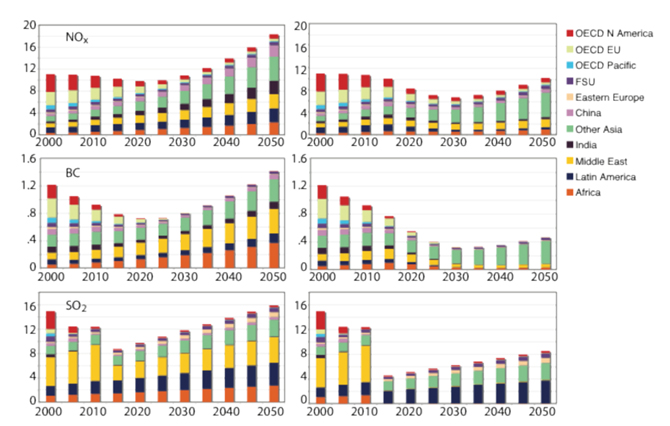Also discussed here: Cleaner Vehicle Standards Good for Health, Agriculture, Climate (National Aeronautics and Space Administration, Apr. 1, 2011)
Also here: The Benefits of Stronger air pollution standards for Cars and Trucks (Next Big Future, Apr. 4, 2011)
Today’s review article looks at the link between vehicle emission and climate change and how that affects human health, agriculture and the economy around the world. What is most striking perhaps is the shift of the largest emissions from North America to India and China on the one hand and the overall increase in each of the major pollutants over the next 40 years- with consequences in terms of premature deaths and agricultural crop losses. The other interesting aspect is a comparison of more stringent vehicle emission restrictions in Europe to weaker ones elsewhere- and the impact of this difference in terms of climate change and impacts.

Key Quotes:
“Although much is known about how vehicle emissions affect air quality, there have been fewer studies of how vehicle emissions affect climate.. Emission controls affect individual pollutants differently.. vehicle emissions vary regionally, depending on vehicle ownership and usage rates, vehicle types, and emission and fuel standards,”
“Emission scenarios were developed for the years 2000 2050 in five-year increments for nitrogen oxides (NO x ), carbon monoxide (CO), volatile organic compounds, sulphur dioxide (SO 2 ), black carbon (the strongly absorbing fraction of particulate carbon emissions), organic carbon, methane, nitrous oxide and hydrofluorocarbons”
“Imposition of tight standards can also reverse the baseline increase in deaths between 2000 and 2030 owing to vehicle emissions in China, India, Latin America, Africa and the Middle East”
“current vehicle-emission trends, if fully implemented, will substantially decrease radiative forcing, premature deaths and ozone-related agricultural yield losses for North America and Europe, with the opposite for Africa and the Middle East. For China, India and Latin America”
"The adoption of aggressive standards by 2015 would set the world on a course to prevent the deaths of 200,000 people, save 13 million tons of cereal grains from ozone damage, and save $1.5 trillion in health damages each year after 2030.. For comparison, the United Nations estimated that the earthquake and tsunami that struck the northeast coast of Honshu had caused about 27,600 deaths and produced between $185 and $308 billion in damages at the end of March. Hurricane Katrina killed 1,836 people and produced about $81 billion in damages."
Related articles
- Does Better Urban Design Beat Better Car Design when it comes to Emissions? (pollutionfreecities.blogspot.com)
- Does Ethanol in Fuel Make Vehicle Emissions Less Harmful? (pollutionfreecities.blogspot.com)
- Urban Vulnerability to Climate Change (pollutionfreecities.blogspot.com)
- Green Machine: Emissions cuts could save 280,000 lives (newscientist.com)
- The Benefits of Stronger air pollution standards for Cars and Trucks (nextbigfuture.com)
- Strategy on climate change to be done early June (lookatvietnam.com)
- UN climate chief predicts US turnaround on warming (seattletimes.nwsource.com)

No comments:
Post a Comment